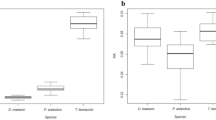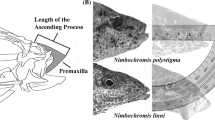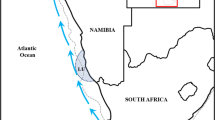Abstract
There is scant information available on the ecomorphology of Antarctic fishes, and especially on their feeding capabilities. We measured interspecific variation in mechanical advantage (MA), force-producing capability, and suction index for the jaws of the five dominant taxa of high-Antarctic fishes: the nototheniid Trematomus bernacchii; the zoarcids Pachycara brachycephalum, Lycodichthys dearborni, and Ophthalmolycus amberensis; and the liparid Paraliparis devriesi. Analysis of variance indicated significant differences in jaw metrics, and ordinations of morphological traits identified three loosely defined groups reflecting their family-level taxonomy. Principal component analyses showed distinct segregation between the nototheniid and the liparid, indicating that they are at the extremes of the feeding performance continuum. The zoarcids fell in the middle, suggesting that they utilize a combination of feeding modes to capture prey. The liparid had the lowest MA and bite force, but a large epaxialis implied a ram-suction-feeding mode. The large adductor mandibulae in the zoarcids P. brachycephalum and L. dearborni suggest that they are capable of grasping mobile prey and manipulating sedentary, hard-shelled macroinvertebrates. The zoarcids had a smaller epaxialis than the liparid and may not be as efficient as suction-feeders. Values for mechanical advantage ratios and suction indices in Antarctic fishes were within the range known for non-Antarctic fishes. The five Antarctic species do not possess dentition specialized for durophagous feeding; however, the high mechanical advantage ratio in the nototheniid and, to a lesser extent, in the zoarcids, suggests that durophagy may be possible.




Similar content being viewed by others
References
Anderson ME (1990) Zoarcidae. In: Gon O, Heemstra PC (eds) Fishes of the Southern Ocean. J.L.B. Smith Institute of Ichthyology, Grahamstown, pp 256–276
Anderson ME (1994) Systematics and osteology of the Zoarcidae (Teleostei: Perciformes). Ichthyol Bull JLB Smith Inst Ichthyol 60:1–120
Andriashev AP (1965) A general review of the Antarctic fish fauna. In: van Oye P, van Mieghem J (eds) Biogeography and ecology in Antarctica, Monographiae Biologicae, vol XV. Junk, The Hague, pp 491–550
Andriashev AP (1980) A new liparid fish in McMurdo Sound. Antarct J US 15:150
Andriashev AP (1991) Possible pathways of Paraliparis (Pisces: Liparididae) and some other North Pacific secondarily deep-sea fishes into North Atlantic and Arctic depths. Polar Biol 11:213–218
Andriashev AP (2003) Liparid Fishes (Liparidae, Scorpaeniformes) of the Southern Ocean and Adjacent Waters. Series “Biological Results of the Russian Antarctic Expeditions”, Vol. 9. Explorations of the Fauna of the Seas, vol 53(61). Russian Academy of Sciences, Zoological Institute, St. Petersburg
Andriashev AP, Stein DL (1998) Review of the snailfish genus Careproctus (Liparidae, Scorpaeniformes) in Antarctic and adjacent waters. Contrib Sci Nat Hist Mus Los Angeles Co 470:1–63
Aronson RB, Blake DB (2001) Global climate change and the origin of modern benthic communities in Antarctica. Am Zool 41:27–39
Aronson RB, Thatje S, Clarke A, Peck LS, Blake DB, Wilga CD, Seibel BA (2007) Climate change and invasibility of the Antarctic benthos. Annu Rev Ecol Evol Syst 38:129–154
Balushkin AV (2012) Volodichthys gen. nov. new species of the primitive snailfish (Liparidae: Scorpaeniformes) of the Southern Hemisphere. Description of new species V. solovjevae sp. nov. (Cooperation Sea, the Antarctic). J Ichthyol 52:1–10
Barnett A, Bellwood DR, Hoey AS (2006) Trophic ecomorphology of cardinalfish. Mar Ecol Prog Ser 322:249–257
Barrera E, Tevesz MJS, Carter JG (1990) Variations in oxygen and carbon isotopic compositions and microstructure of the shell Adamussium colbecki (Bivalvia). Palaios 5:149–159
Barrera-Oro E (2002) The role of fish in the Antarctic marine food web: differences between inshore and offshore waters in the southern Scotia Arc and west Antarctic Peninsula. Antarct Sci 14:293–309
Belman BW, Anderson ME (1979) Aquarium observations on feeding by Melanostigma pammelas (Pisces: Zoarcidae). Copeia 2:366–369
Boulenger GA (1902) Pisces report on the collections of natural history made in the Antarctic Regions During the Voyage of the “Southern Cross”. British Museum (Natural History), London, pp 174–189
Carroll AM, Wainwright PC, Huskey SH, Collar DC, Turingan RG (2004) Morphology predicts suction feeding performance in centrarchid fishes. J Exp Biol 207:3873–3881
Casaux R, Barrera-Oro E, Baroni A, Ramón A (2003) Ecology of inshore notothenioid fish from the Danco Coast, Antarctic Peninsula. Polar Biol 26:157–165
Clarke A, Aronson RB, Crame JA, Gili J-M, Blake DB (2004) Evolution and diversity of the benthic fauna of the Southern Ocean continental shelf. Antarct Sci 16:559–568
Collar DC, Wainwright PC (2006) Discordance between morphological and mechanical diversity in the feeding mechanism of centrarchid fishes. Evolution 60:2575–2584
Daniels RA (1982) Feeding ecology of some fishes of the Antarctic Peninsula. Fish Bull US 80:575–588
Eastman JT (2005) The nature of the diversity of Antarctic fishes. Polar Biol 28:93–107
Eastman JT, Lannoo MJ (1998) Morphology of the brain and sense organs in the snailfish Paraliparis devriesi: neural convergence and sensory compensation on the Antarctic shelf. J Morphol 237:213–236
Eastman JT, Hikida RS, DeVries AL (1994) Buoyancy studies and microscopy of skin and subdermal extracellular matrix of the Antarctic snailfish, Paraliparis devriesi. J Morphol 220:85–101
Eastman JT, Witmer LM, Ridgely RC, Kuhn KL (2014) Divergence in skeletal mass and bone morphology in Antarctic notothenioid fishes. J Morphol 275:841–861
Fanta E, Rios FS, Meyer AA (2001a) Behaviour of the Antarctic fish Ophthalmolycus amberensis (Zoarcidae) on gravel and muddy bottom. Antarct Rec Natl Inst Polar Res Tokyo 45:13–26
Fanta E, Rios FS, Meyer AA, Grötzner SR, Zaleski T (2001b) Chemical and visual sensory systems in feeding behaviour of the Antarctic fish Ophthalmolycus amberensis (Zoarcidae). Antarct Rec Natl Inst Polar Res Tokyo 45:27–42
Fink WL (1981) Ontogeny and phylogeny of tooth attachment mode in actinopterygian fishes. J Morphol 167:167–184
Fujii T, Jamieson AJ, Solan M, Bagley PM, Priede IG (2010) A large aggregation of liparids at 7703 meters and a reappraisal of the abundance and diversity of hadal fish. Bioscience 60:506–515
Galis F (1993) Interactions between the pharyngeal jaw apparatus, feeding behaviour, and ontogeny in the cichlid fish, Haplochromis piceatus: a study of morphological constraints in evolutionary ecology. J Exp Zool 267:137–154
Gon O, Heemstra PC (eds) (1990) Fishes of the Southern Ocean. JLB Smith Institute of Ichthyology, Grahamstown
Grubich J (2003) Morphological convergence of pharyngeal jaw structure in durophagous fish. Biol J Linn Soc 80:147–165
Higham TE, Day SW, Wainwright PC (2005) Sucking while swimming: evaluating the effects of ram speed on suction generation in bluegill sunfish Lepomis macrochirus using digital particle image velocimetry. J Exp Biol 208:2653–2660
Hureau J-C (1970) Biologie comparée de quelques Poissons antarctiques (Nototheniidae). Bull Inst Océanogr Monaco 68:1–244
Huskey SH, Turingan RG (2001) Variation in prey-resource utilization and oral jaw gape between two populations of largemouth bass, Micropterus salmoides. Environ Biol Fish 61:185–194
Iglésias SP, Dettai A, Ozouf-Costaz C (2012) Barbapellis pterygalces, new genus and species of a singular eelpout (Zoarcidae: Teleostei) from the Antarctic deep waters. Polar Biol 35:215–220
Il’insky EN, Kuznetsova NA (2010) Spatial and length distribution, sex composition, and feeding of the notched-fin eelpout Zoarces elongatus (Perciformes: Zoarcidae) in the Sea of Okhotsk. Russ J Mar Biol 36:252–257
Iwami T (2004) Comparative morphology of the adductor mandibulae musculature of notothenioid fishes (Pisces, Perciformes). Antarct Sci 16:17–21
Iwami T, Kock K-H (1990) Channichthyidae. In: Gon O, Heemstra PC (eds) Fishes of the Southern Ocean. J.L.B. Smith Institute of Ichthyology, Grahamstown, pp 381–399
Jamieson AJ, Fujii T, Solan M, Matsumoto AK, Bagley PM, Priede IG (2009) Liparid and macrourid fishes of the hadal zone: in situ observations of activity and feeding behaviour. Proc R Soc B 276:1037–1045
Kiest KA (1993) A relationship of diet to prey abundance and the foraging behavior of Trematomus bernacchii. Polar Biol 13:291–296
Klingenberg CP, Ekau W (1996) A combined morphometric and phylogenetic analysis of an ecomorphological trend: pelagization in Antarctic fishes (Perciformes: Nototheniidae). Biol J Linn Soc 59:143–177
Kock K-H (2005) Antarctic icefishes (Channichthyidae): a unique family of fishes. A review, part I. Polar Biol 28:862–895
Kock K-H, Gröger J, Jones CD (2013) Interannual variability in the feeding of ice fish (Notothenioidei, Channichthyidae) in the southern Scotia Arc and the Antarctic Peninsula region (CCAMLR subareas 48.1 and 48.2). Polar Biol 36:1451–1462
La Mesa M, Dalú M, Vacchi M (2004a) Trophic ecology of the emerald notothen Trematomus bernacchii (Pisces, Nototheniidae) from Terra Nova Bay, Ross Sea, Antarctica. Polar Biol 27:721–728
La Mesa M, Eastman JT, Vacchi M (2004b) The role of notothenioid fish in the food web of the Ross Sea shelf waters: a review. Polar Biol 27:321–338
Lannoo MJ, Eastman JT (2000) Nervous and sensory system correlates of an epibenthic evolutionary radiation in Antarctic notothenioid fishes, genus Trematomus (Perciformes; Nototheniidae). J Morphol 245:67–79
Lannoo MJ, Eastman JT (2006) Brain and sensory organ morphology in Antarctic eelpouts (Perciformes: Zoarcidae: Lycodinae). J Morphol 267:115–127
Lauder GV (1982) Patterns of evolution in the feeding mechanism of actinopterygian fishes. Am Zool 22:275–285
Lauder GV (1983) Prey capture hydrodynamics in fishes: experimental tests of two models. J Exp Biol 104:1–13
Liem KF (1980) Acquisition of energy by teleosts: adaptive mechanisms and evolutionary patterns. In: Ali MA (ed) Environmental physiology of fishes. Plenum Press, New York, pp 229–334
Liem KF (1993) Ecomorphology of the teleostean skull. In: Hanken J, Hall BK (eds) The skull, vol 3, functional and evolutionary mechanisms. University of Chicago Press, Chicago, pp 422–452
Matallanas J (2009) Description of Gosztonyia antarctica, a new genus and species of Zoarcidae (Teleostei: Perciformes) from the Antarctic Ocean. Polar Biol 32:15–19
Matallanas J (2010) Description of two new genera, Santelmoa and Bentartia and two new species of Zoarcidae (Teleostei, Perciformes) from the Southern Ocean. Polar Biol 33:659–672
Matallanas J, Olaso I (2007) Fishes of the Bellingshausen Sea and Peter I Island. Polar Biol 30:333–341
Matallanas J, Corbella C, Møller PR (2012) Description of two new species of Santelmoa (Teleostei, Zoarcidae) from the Southern Ocean. Polar Biol 35:1395–1405
Montgomery JC, Foster BA, Milton RC, Carr E (1993) Spatial and temporal variations in the diet of nototheniid fish in McMurdo Sound, Antarctica. Polar Biol 13:429–431
Moreno CA (1980) Observations on food and reproduction in Trematomus bernacchii (Pisces: Nototheniidae) from the Palmer Archipelago, Antarctica. Copeia 1:171–173
Near TJ, Dornburg A, Kuhn KL, Eastman JT, Pennington JN, Patarnello T, Zane L, Fernández DA, Jones CD (2012) Ancient climate change, antifreeze, and the evolutionary diversification of Antarctic fishes. Proc Natl Acad Sci USA 109:3434–3439
Nemeth DH (1997) Modulation of attach behavior and its effect on feeding performance in the trophic generalist fish, Hexagrammos decagrammus. J Exp Biol 200:2155–2164
North AW (1996) Locomotory activity and behaviour of the Antarctic teleost Notothenia coriiceps. Mar Biol 126:125–132
Norton SF, Brainerd EL (1993) Convergence in the feeding mechanics of ecomorphologically similar species in the Centrarchidae and Cichlidae. J Exp Biol 176:11–29
Reid WDK, Clarke S, Collins MA, Belchier M (2007) Distribution and ecology of Chaenocephalus aceratus (Channichthyidae) around South Georgia and Shag Rocks (Southern Ocean). Polar Biol 30:1523–1533
Sancho G, Fisher CR, Mills S, Micheli F, Johnson GA, Lenihan HS, Peterson CH, Mullineaux LS (2005) Selective predation by the zoarcids fish Thermarces cerberus at hydrothermal vents. Deep-Sea Res I 52:837–844
Scharf FS, Juanes F, Rountree RA (2000) Predator size-prey size relationships of marine fish predators: interspecific variation and effects of the ontogeny and body size on trophic-niche breadth. Mar Ecol Prog Ser 208:229–248
Smith CR, Grange LJ, Honig DL, Naudts L, Huber B, Guidi L, Domack E (2012) A large population of king crabs in Palmer Deep on the west Antarctic Peninsula shelf and potential invasive impacts. Proc R Soc B 279:1017–1026
Stein DL (2012) Snailfishes (family Liparidae) of the Ross Sea, Antarctica, and closely adjacent waters. Zootaxa 3285:1–120
Stein DL, Felley JD, Vecchione M (2005) ROV observations of benthic fishes in the Northwind and Canada Basins, Arctic Ocean. Polar Biol 28:232–237
Targett TE (1981) Trophic ecology and structure of coastal Antarctic fish communities. Mar Ecol Prog Ser 4:243–263
Turingan RG, Wainwright PC, Hensley DA (1995) Interpopulation variation in prey use and feeding biomechanics in Caribbean triggerfishes. Oecologia 102:296–304
Vacchi M, La Mesa M, Castelli A (1994) Diet of two coastal nototheniid fish from Terra Nova Bay, Ross Sea. Antarct Sci 6:61–65
Vacchi M, Cattaneo-Vietti R, Chiantore M, Dalu M (2000) Predator-prey relationship between the nototheniid fish Trematomus bernacchii and the Antarctic scallop Adamussium colbecki at Terra Nova Bay (Ross Sea). Antarct Sci 12:64–68
Wainwright PC (1988) Morphology and ecology: functional basis of feeding constraints in Caribbean labrid fishes. Ecology 69:635–645
Wainwright PC (1991) Experimental functional anatomy for ecological problems. Am Zool 31:680–693
Wainwright PC (1996) Ecological explanation through functional morphology: the feeding biology of sunfishes. Ecology 77:1336–1343
Wainwright PC (2006) Functional morphology of the pharyngeal jaw apparatus. In: Shadwick RE, Lauder GV (eds) Fish biomechanics, vol 23, fish physiology. Elsevier Academic Press, San Diego, pp 77–101
Wainwright PC, Bellwood DR (2002) Ecomorphology of feeding in coral reef fishes. In: Sale PF (ed) Coral reef fishes: dynamics and diversity in a complex ecosystem. Academic Press, San Diego, pp 33–55
Wainwright PC, Richard BA (1995) Predicting patterns of prey use from morphology of fishes. Environ Biol Fish 44:97–113
Wainwright PC, Ferry-Graham LA, Waltzek TB, Carroll AM, Hulsey CD, Grubich JR (2001) Evaluating the use of ram and suction during prey capture by cichlid fishes. J Exp Biol 204:303–93051
Wainwright P, Carroll M, Collar DC, Day SW, Higham TE, Holzman RA (2007) Suction feeding mechanics, performance, and diversity in fishes. Integr Comp Biol 47:96–106
Watson S-A, Peck LS, Tyler PA, Southgate PC, Tan KS, Day RW, Morley SA (2012) Marine invertebrate skeleton size varies with latitude, temperature, and carbonate saturation: implications for global change and ocean acidification. Glob Change Biol 18:3026–3038
Westneat MW (2004) Evolution of levers and linkages in the feeding mechanisms of fishes. Integr Comp Biol 44:378–389
Westneat MW (2006) Skull biomechanics and suction feeding in fishes. In: Shadwick RE, Lauder GV (eds) Fish biomechanics, vol 23, fish physiology. Elsevier Academic Press, San Diego, pp 29–75
Winterbottom R (1974) A descriptive synonymy of the striated muscles of the Teleostei. Proc Acad Nat Sci Phila 125:225–317
Acknowledgments
We thank K.E. Smith, S. Thatje, L.T. Toth, and especially R.G. Turingan for helpful advice and discussion. This research was supported by grants from the U.S. National Science Foundation: ANT-9416870 and ANT-0436190 to J.T.E., and ANT-0838846 and ANT-1141877 to R.B.A. We are also grateful to Danette Pratt for assembling the figures and to John Sattler for photography. This is contribution 125 from the Institute for Research on Global Climate Change at the Florida Institute of Technology.
Author information
Authors and Affiliations
Corresponding author
Rights and permissions
About this article
Cite this article
Bansode, M.A., Eastman, J.T. & Aronson, R.B. Feeding biomechanics of five demersal Antarctic fishes. Polar Biol 37, 1835–1848 (2014). https://doi.org/10.1007/s00300-014-1565-z
Received:
Revised:
Accepted:
Published:
Issue Date:
DOI: https://doi.org/10.1007/s00300-014-1565-z




